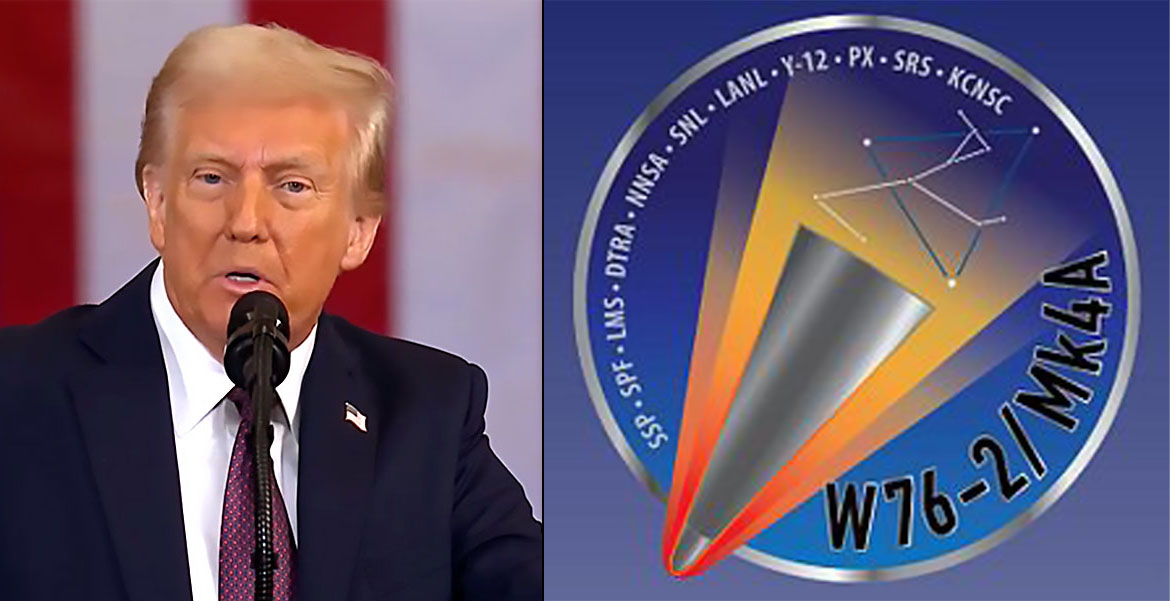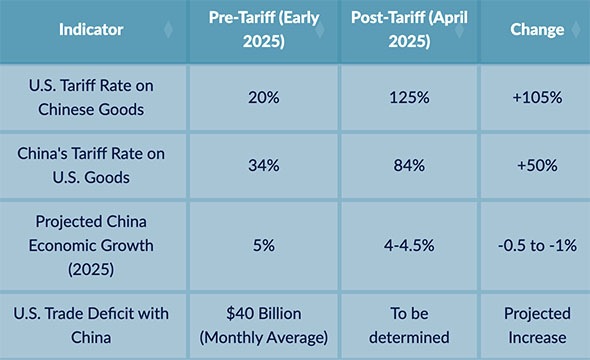Trump’s Trade War and Secret Military Arsenals
10 April 2025 - News@NewsVoice
Images by C-Span and NNSANews

Donald Trump and a W76-2 warhead.
U.S. President Donald Trump has again ignited trade tensions, particularly with China. On April 9, 2025, Trump announced a significant increase in tariffs on Chinese goods, escalating them to a staggering 125%. Simultaneously, he declared a 90-day pause on reciprocal tariffs for most other nations, a decision framed as a reprieve amidst growing economic uncertainty.Trump’s Tariff Tactics: President Trump has raised tariffs on Chinese goods to 125% while implementing a 90-day pause on tariffs for most other countries.
Economic Impact: These tariffs are projected to significantly impact China’s economic growth, potentially reducing it to as low as 4% in 2025.
Secret Weapon Claims: Trump’s recent boasts about previously undisclosed U.S. military weaponry have sparked global speculation and unease.
The Breakdown of Tariffs
The decision to raise tariffs on China follows an earlier threat to impose a 50% tariff on Chinese goods if Beijing did not withdraw its levies on U.S. products. This tit-for-tat escalation has plunged the world’s two largest economies into a full-blown trade war.
The 125% tariff means a $10 product would now attract a $12.50 tax, driving the total cost up to $22.50. These costs are typically borne by the companies importing the goods, who decide whether to pass them on to consumers.
Global Market Reactions
The immediate reaction to Trump’s announcement was a surge in global stock markets, as investors hoped to resolve the trade disputes. However, the reprieve was short-lived. China retaliated swiftly, announcing its measures targeting U.S. goods, particularly agricultural products.
This includes tariffs ranging from 10% to 15% on various U.S. agricultural products. These retaliatory tariffs cannot be waived or exempted under current regulations, further intensifying the economic standoff.
The Impact on China’s Economy
The escalating trade war is expected to have a significant impact on China’s economic growth. Investment banks are forecasting a growth rate of 4.5% for 2025, while analysts at UBS are even more pessimistic, suggesting that Trump’s tariff hikes could reduce China’s economic growth to just 4%.
This projection assumes that the Chinese government will engage in broad fiscal expansion to mitigate the negative effects. The effectiveness of China’s past strategy of rerouting exports through countries like Vietnam and Thailand to bypass U.S. tariffs is also expected to diminish as Trump erects trade barriers globally.
Trump’s ”Secret Weapon”: Fact or Fiction?
Adding to the global unease, President Trump has made several claims about the existence of previously undisclosed U.S. military weaponry. In one instance, Trump boasted about a ”super duper missile” that could fly ”17 times faster” than anything America’s adversaries possess. He has also alluded to a ”secret nuclear weapon” and a ”weapon system that nobody’s ever had in this country before.”
The W76-2 Warhead
Some experts speculate that Trump may have been referring to the W76-2 warhead, a low-yield nuclear weapon deployed on Trident II D-5 missiles carried aboard Navy ballistic missile submarines. While this warhead’s existence was known, its deployment’s timing was initially kept secret.
However, experts suggest the claim of a revolutionary weapon is an overstatement. Low-yield atomic bombs have existed since the 1950s, but their deployment on strategic systems is unprecedented and controversial.
Hypersonic Weapons
Trump has also mentioned his interest in hypersonic weapons, often without using the specific term. Hypersonic weapons are designed to travel at speeds over Mach 5, making them difficult to intercept. While the U.S. is actively developing hypersonic weapons, details of these programs are mainly classified.
Russia has already deployed hypersonic weapons, such as the Kinzhal, Oreshnik, and Zircon missiles, which give it a potential advantage in this area.
The Implications of Trump’s Claims
The implications of Trump’s claims are multifaceted. On one hand, they could deter potential adversaries and project an image of the U.S.’s alleged military superiority. On the other hand, they could increase global tensions and spur an arms race as other nations seek to match or surpass U.S. military capabilities. The lack of transparency surrounding these claims also raises concerns about the potential for miscalculation and escalation in times of crisis.
China Responds with Assertiveness and Caution
Amidst the escalating trade war and the unveiling of supposed U.S. military advancements, China has adopted a posture of assertive defense and cautious diplomacy. Beijing has consistently emphasized its commitment to protecting its interests while advocating for a return to dialogue and cooperation.
Retaliatory Measures
In direct response to the increased tariffs imposed by the U.S., China has implemented retaliatory measures targeting U.S. agricultural products. These tariffs, ranging from 10% to 15%, aim to exert economic pressure on the U.S. and demonstrate China’s resolve to defend its monetary sovereignty. Unlike previous tariffs, these cannot be waived, signaling a firm stance.
Travel Advisories
Adding another layer to the countermeasures, the Chinese Ministry of Culture and Tourism issued a travel advisory cautioning its citizens about the risks of visiting the U.S. The advisory cited the deterioration of China-U.S. economic relations and concerns over safety in the U.S., urging Chinese tourists to exercise caution. This move is likely to impact tourism revenue in the U.S.
Commitment to Peaceful Development
Despite the tensions, China has reiterated its commitment to peaceful development and win-win cooperation. Chinese officials have emphasized the importance of resolving trade disputes through dialogue and negotiation, underscoring the mutual benefits of a stable and cooperative relationship. This approach reflects China’s broader foreign policy strategy of promoting multilateralism and global governance.
Visualizing the Trade War: Key Indicators
The following table illustrates the key indicators reflecting the trade war between the U.S. and China, showcasing the economic impact and the escalating tensions:

Trade War April 2025 – Key Indicators Table by Ithy.com
Decoding Trump’s Tariff Strategy: KTLA 5 News AnalysisThis video from KTLA 5 News provides a concise breakdown of President Trump’s decision to implement a 90-day pause on most tariffs while simultaneously increasing tariffs on Chinese imports. The analysis highlights the immediate market reactions and potential implications for global trade.
References
NewsVoice is an online Swedish news and debate channel that started in 2011. The purpose is to publish independent news, debate articles and comments as well as analyzes.
News@NewsVoice
news@newsvoice.se
News@NewsVoice
news@newsvoice.se
No comments:
Post a Comment